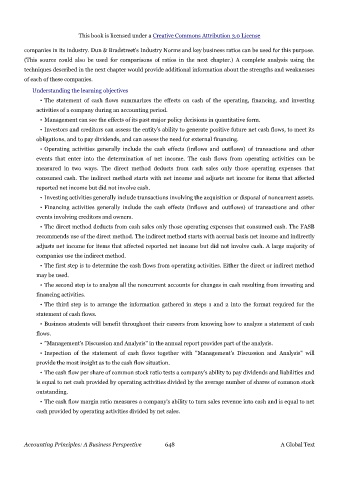Page 647 - Accounting Principles (A Business Perspective)
P. 647
This book is licensed under a Creative Commons Attribution 3.0 License
companies in its industry. Dun & Bradstreet's Industry Norms and key business ratios can be used for this purpose.
(This source could also be used for comparisons of ratios in the next chapter.) A complete analysis using the
techniques described in the next chapter would provide additional information about the strengths and weaknesses
of each of these companies.
Understanding the learning objectives
• The statement of cash flows summarizes the effects on cash of the operating, financing, and investing
activities of a company during an accounting period.
• Management can see the effects of its past major policy decisions in quantitative form.
• Investors and creditors can assess the entity's ability to generate positive future net cash flows, to meet its
obligations, and to pay dividends, and can assess the need for external financing.
• Operating activities generally include the cash effects (inflows and outflows) of transactions and other
events that enter into the determination of net income. The cash flows from operating activities can be
measured in two ways. The direct method deducts from cash sales only those operating expenses that
consumed cash. The indirect method starts with net income and adjusts net income for items that affected
reported net income but did not involve cash.
• Investing activities generally include transactions involving the acquisition or disposal of noncurrent assets.
• Financing activities generally include the cash effects (inflows and outflows) of transactions and other
events involving creditors and owners.
• The direct method deducts from cash sales only those operating expenses that consumed cash. The FASB
recommends use of the direct method. The indirect method starts with accrual basis net income and indirectly
adjusts net income for items that affected reported net income but did not involve cash. A large majority of
companies use the indirect method.
• The first step is to determine the cash flows from operating activities. Either the direct or indirect method
may be used.
• The second step is to analyze all the noncurrent accounts for changes in cash resulting from investing and
financing activities.
• The third step is to arrange the information gathered in steps 1 and 2 into the format required for the
statement of cash flows.
• Business students will benefit throughout their careers from knowing how to analyze a statement of cash
flows.
• "Management's Discussion and Analysis" in the annual report provides part of the analysis.
• Inspection of the statement of cash flows together with "Management's Discussion and Analysis" will
provide the most insight as to the cash flow situation.
• The cash flow per share of common stock ratio tests a company's ability to pay dividends and liabilities and
is equal to net cash provided by operating activities divided by the average number of shares of common stock
outstanding.
• The cash flow margin ratio measures a company's ability to turn sales revenue into cash and is equal to net
cash provided by operating activities divided by net sales.
Accounting Principles: A Business Perspective 648 A Global Text

